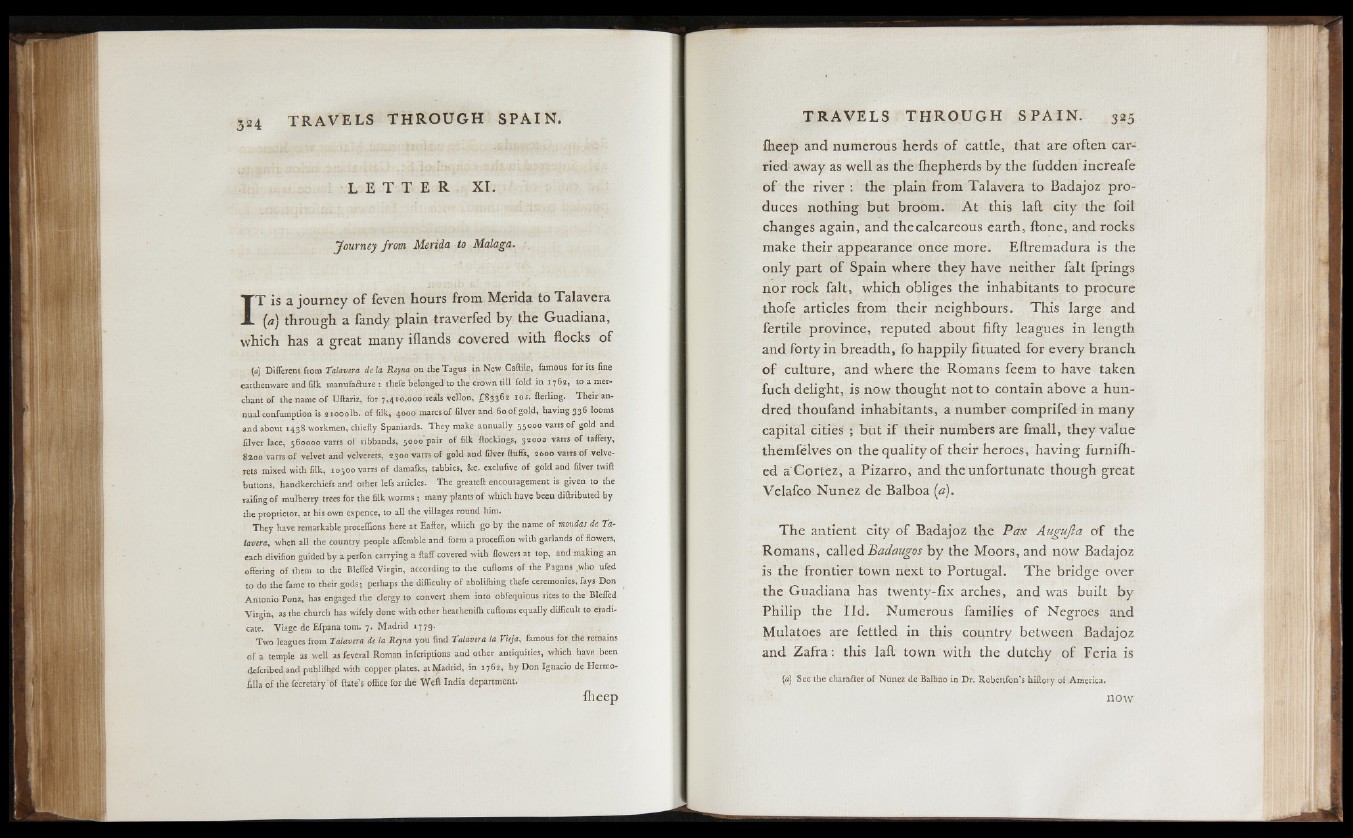
L E T T E R XI.
yourney Jrom Merida to Malaga.
IT is a journey o f feven hours from Merida to Talavera
[a) through a fandy plain traverfed by the Guadiana,
which has a great many iilands covered with flocks o f
(a) Different from Talavera de la Reyna on the Tagus in New Caftile, famous for its fine
earthenware and filk manufa&ure : thefe belonged to the crown till fold in 1762, to a merchant
of the name o f Uftariz, f o r 7,410,00© reals vellon, £83362 lo r. flerling. Their annual
confumption is arooolb. of filk, 4000 marcs of filver and 60 o f gold, having 336 looms
and about 1438 workmen, chiefly Spaniards. They make annually 55000 varrs o f gold and
filver lace, 560000 vam of ribbands, 5000 pair of filk ftockings, 32000 varrs of taffety,
8200 varrs o f velvet and velverets, 2300 varrs of gold and filver fluffs, 2000 vaiTSof velve-
rets mixed with filk, 10500 varrs o f damafks, tabbies, 8cc. exdufive of gold and filver twifl
buttons, handkerchiefs and other lefs articles. The greateft encouragement is given to the
raifing o f mulberry trees for the filk worms; many plants of which have been diftributed by
the proprietor, at his own expence, to all the villages round him.
They have remarkable proceffions here at Eafter, which go by the name of moudas de Talavera,,
when all the country people affemble and form a procefiion with garlands of flowers,
each divifion guided by a perfon carrying a flaff covered with flowers at top, and making an
offering of them to the Bleffed Virgin, according to the culloms of the Pagans who ufed
to do the fame to their gods; perhaps the difficulty of abolifhing thefe ceremonies, fays Don
Antonio Ponz, has engaged the clergy to convert them into obfequious rites to the Bleffed
Virgin, as the church has wifely done with other heathenifh culloms equally difficult to eradicate.
Viage de Efpana tom. 7. Madrid 17 79 .'
Two leagues from Talavera de la Reyna you find Talavera la Vieja, famous for the remains
of a temple as well as feveral Roman infcriptions and other antiquities, which have been
defcribed and publifhid with copper plates, atjijtadrid, in 2762, by Don Ignacio de Herrro-
¿ 11a of the fecretary of Hate’s office for the Weft India department.
fheep
iheep and numerous herds of cattle, that are often carried
away as well as the ihepherds by the fudden increafe
o f the river : the plain from Talavera to Badajoz produces
nothing but broom. At this laft city the foil
changes again, and thecalcareous earth, ftone, and rocks
make their appearance once more. Eftremadura is the
only part o f Spain where they have neither fait fprings
nor rock fait, which obliges the inhabitants to procure
thofe articles from their neighbours. This large and
fertile province, reputed about fifty leagues in length
and forty in breadth, fo happily fituated for every branch
o f culture, and where the Romans feem to have taken
fuch delight, is now thought not to contain above a hundred
thoufand inhabitants, a number comprifed in many
capital cities ; but if their numbers are fmall, they value
themfelves on the quality of their heroes, having furnifh-
ed a'Cortez, a Pizarro, and the unfortunate though great
Velafco Nunez de Balboa («).
The antient city of Badajoz the Pax Augujla o f the
Romans, called Badaugos by the Moors, and now Badajoz
is the frontier town next to Portugal. The bridge over
the Guadiana has twenty-fix arches, and was built by
Philip the lid . Numerous families of Negroes and
Mulatoes are fettled in this country between Badajoz
and Zafra: this lafl town with the dutchy o f Feria is
(a) See the chara&er of Nunez de Balbao in Dr. Robertfon’s hiitory of America.
now